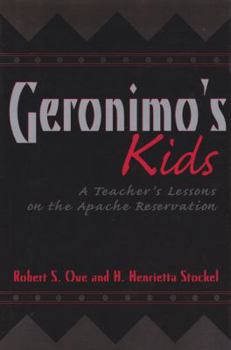Geronimo's Kids: A Teacher's Lessons on the Apache Reservationvolume 16
(Book #16 in the Elma Dill Russell Spencer Series in the West and Southwest Series)
Select Format
Select Condition 
Book Overview
Totally ignorant of what the Chiricahuas had endured and survived, in my one-room classroom at Whitetail I taught Geronimo's kids American history, including the 'fact' that the Indians of the Southwest had to be subdued by every means possible so that the settlers, the miners, the ranchers, the sheep farmers, the adventurers, the missionaries, and everyone else who wanted the Apache homelands could live peacefully on the land. If only I had known . . .Arriving on the Mescalero Apache Reservation in 1948, Robert Ove, a naive young school teacher, began his first teaching job at Whitetail, ignorant of the culture and history of his Chiricahua students, descendants of the great chief Geronimo. The Chiricahua gradually accepted this well-intentioned outsider into their community and shared parts of their history and culture with him. Living among this reminder of America's past, Ove glimpsed a way of life that few Americans had been allowed to know. He saw Apache mothers still carrying their infants in cradleboards, grandmothers and mothers still sewing traditional beaded buckskin dresses for their daughters' puberty ceremonies, and men still making traditional Apache bows and arrows. Through the stories of the elders, he also learned how this way of life had changed since their capture, as many of the traditional ways of the Chiricahua were altered or lost in the ensuing decades after Geronimo's people surrendered to the U.S. Army in 1886. Decades of incarceration followed--first in Florida, then in Alabama, and finally in Oklahoma. More than half died in hot, humid prison camps because the Chiricahuas had no inborn resistance to the virulent diseases brought to North America by Europeans. Then in 1913, with fewer than three hundred left, the Chiricahuas were released and received land allotments near their last prison site, Fort Sill, or on the Mescalero Apache Reservation where Ove arrived thirty-five years later. In Geronimo's Kids, Robert Ove gives a stirring account of his life from 1948 to 1950 when he taught day school at the community on the reservation. His personal observations as well as past and recent photographs, against Henrietta Stockel's background of historical reference, help to preserve this fragment of history to give insight into those who became his students, neighbors, and friends. Those interested in the fate of Geronimo's people and their story will find Ove's account enlightening and insightful. With Stockel's contributions, scholars will find this book an invaluable resource on daily reservation life in the 1940s.
Format:Hardcover
Language:English
ISBN:0890967741
ISBN13:9780890967744
Release Date:October 1997
Publisher:Texas A&M University Press
Length:200 Pages
Weight:1.15 lbs.
Dimensions:0.9" x 6.3" x 9.3"
Customer Reviews
1 rating
A much-needed study of multicultural relationships
Published by Thriftbooks.com User , 16 years ago
I came across this book by accident at the local library, looking for contempary books on Native Americans. This one caught my eye, as I am a teacher-in-training and also a lover of all things Native American. Ove took this job with the Bureau of Indian Affairs (BIA) in 1948 because he needed a job. Not quite a college graduate from southern Illinois, but anxious to get started, he got talked into taking this one-room school house job in south-central New Mexico. The Apache children, who seemed estranged by his lack of the Apache language and culture, took to him faster than the elders on the reservation. They respected him, but kept their distance from him. Poor Ove fumbled after one misstep after the other, with no real experience as an elementary teacher. He and his new bride were lost in the world of the Apache. But he never gave up. Even before his two-year stint was over he learned to appreciate the Apache for everything they offered, ideas that the European culture didn't (and still doesn't) offer. The racist policies of the BIA and of white people of the post-WWII era ("The Greatest Generation" that was also one of the most abusive to Native Americans and Blacks), the bureaucratic red tape of government regulations, and the manipulation of young college kids all come out in the open in this book. This is a great little book for new teachers who want to go out into the teaching world and do the right thing, a book for young hearts who also want to do their best in a strange new world. The writing style is symplistic but the inspiration, faith and even sorrow prevail in this book. The author wrote his memoirs 50 years after leaving Whitetail Reservation, yet the story reads like something that just happened yesterday. I have to wonder how much more detail he could have provided had he not waited so long to write this pleasant memoir. The second half of this book is mostly interviews with some of his former students 30 years later. Most, sadly, remained on or near the reservation and many had succumbed to alcoholism. A few had already passed on.






